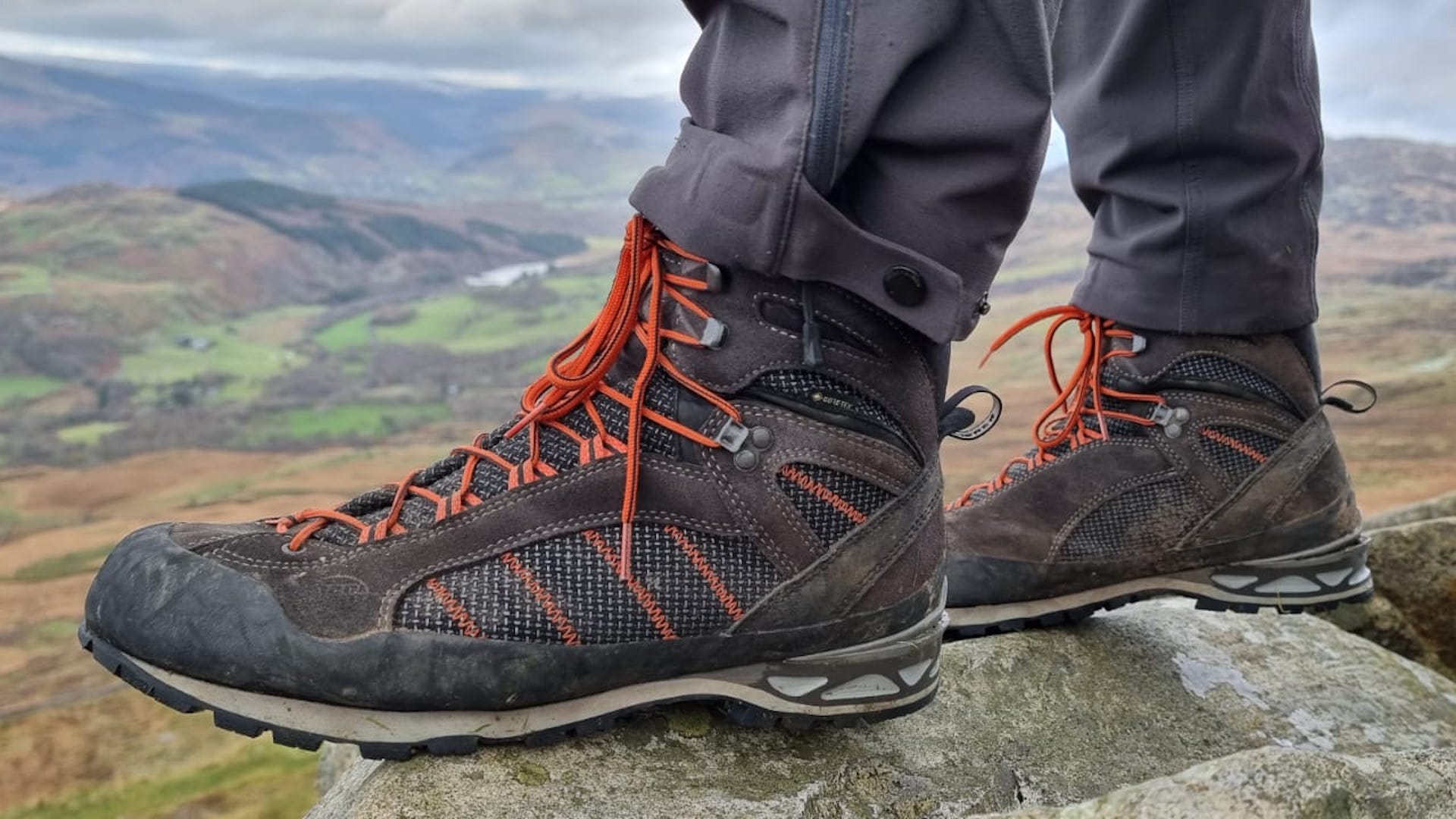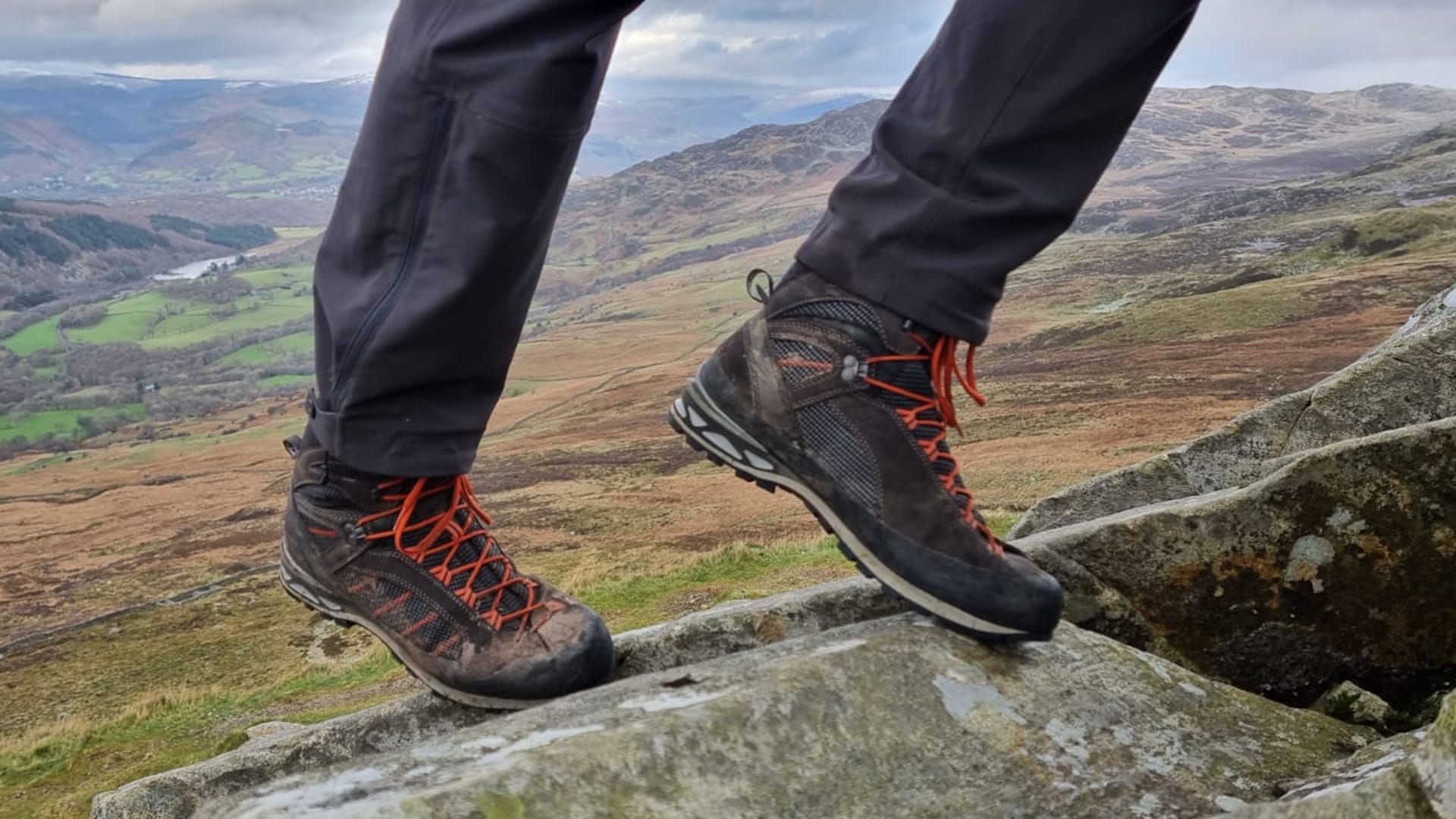Advnture Verdict
A capable rock-hopper with the added ability to handle snow and ice. Although they’re most at home when scrambling, the accommodating fit and hard-wearing construction means they are decent all-rounders for winter hillwalking too.
Pros
- +
Impressively lightweight
- +
Comfortable, accommodating fit
- +
Well-made and durable
Cons
- -
Relatively poor grip on mud and grass
- -
Not the best cushioning underfoot
You can trust Advnture
Hanwag Makra Combi GTX: first impressions
These Hanwag Makra Combi GTX boots come from a highly regarded German brand with over a century of boot-making heritage. Like almost all boots in their range, the Makra Combi is a handsome beast, though it boasts modern, striking and arguably more stylish looks than many of Hanwag’s more traditional offerings.
That perhaps reflects its hybrid, contemporary design. This is a technical scrambling boot, purpose-built for Alpine terrain and via ferrata-style routes. But it’s also winter-ready, with a stiffened midsole and a heel welt to accommodate a C2 semi-automatic crampon.
When we first tried it on, we were struck by two things: firstly, it’s very comfortable, and secondly, it feels exceptionally light for a “proper” mountain boot. Its low weight is down to the use of suede and Cordura fabric uppers and a special honeycomb sole structure. The great out-of-the-box comfort comes from a wonderfully soft, supple ankle cuff and a generously padded tongue, as well as the fact that it’s built on Hanwag’s Wide Alpine last. This results in a slightly broader forefoot to prevent pressure points when hiking or climbing.
But how did the Makra Combis fare when we put them through their paces for our best winter hiking boots buying guide? Read on…
• RRP: £240 (UK) / €270 (EU)
• Sizes available: (EU) 38-47, (UK) 5-12
• Materials: Suede and Cordura nylon uppers, Gore-Tex membrane lining, Vibram Pepe outsole
• Weight (per boot): 625g / 1lb 6oz
• Colors: Black & Shcwarz / Asphalt & Orange
• Compatibility: Four season, B1-B2
Hanwag Makra Combi GTX: on the trails

Walking in winter conditions inevitably means wearing heavier, sturdier footwear, which can sometimes feel energy-sapping. However, the Makra Combi’s low weight makes these boots feel comparatively nimble and precise, which is great for hillwalking and scrambling alike.
We tested them on a range of classic mountain walks and routes in Snowdonia, North Wales – a region known for its variable conditions, particularly in winter. The Makra Combis are certainly more than capable in such terrain, providing comfort and stability on icy rock and snowy slopes. They also offer excellent ankle support to alleviate foot fatigue over the course of long hill days.
Here’s how they performed in each of the key metrics by which we gauge a hiking boot’s performance (find more on these in how to choose a pair of hiking boots):
All the latest inspiration, tips and guides to help you plan your next Advnture!
Comfort
Out-of-the-box comfort is excellent, thanks to plenty of padding in all the right places and that slightly wider last, which allows plenty of room for toes to splay when walking. In many ways, the Makra Combi deliver the instant comfort of a lightweight fabric boot, despite their sturdier construction, which is an impressive feat.
The extra room in the forefoot also means you can wear thicker socks to keep feet warmer in winter conditions, which partly offsets the boot’s lack of insulation – their only real drawback when it comes to cold-weather comfort.
Having said all that, over the course of a long day in the mountains, we did start to feel a little footsore, which we attributed to the relatively thin and simple insole, and the stiff midsole. This is a common issue with B1 and B2 boots, which was easily alleviated by adding an aftermarket insole, giving a little more cushioning underfoot as well as some extra arch support.
Fit
Fit is, of course, subjective, but we found these to be a superb fit, with no slippage, rolling or rubbing. The unusual Alpine Wide last results in a roomy toe-box with a slimmer midfoot and close-fitting heel cup, providing a good balance between overall support and comfort. We also liked the ankle cuff design, which has a pronounced rear cutaway to relieve pressure on the Achilles. (See also: How should hiking boots fit?)
Performance
These boots perform brilliantly across a range of rocky terrain, from long ridges to scree slopes and steeper scrambles, giving plenty of responsive feel underfoot. The Vibram Pepe soles feature a front climbing zone at the toe for good contact grip on small ledges and pockets. Edging performance is also good.
They’re just as capable with a C1 or C2 crampon fitted, attaching securely with a flexible or semi-automatic binding. The heel welt isn’t the biggest, but this caused no issues with the rear lever of our Black Diamond Serac clip crampons.
They’re also comfortable to walk in, with just enough flex in the forefoot for easy striding. The stiffened midsole might mean you start to feel a little footsore, but as noted previously, this is almost a given with B1 and B2 boots, and is easily fixed with an aftermarket insole.
The only terrain in which these boots struggled a little was on muddy downhills and wet grassy slopes – which, to be fair, isn’t the sort of ground for which they’re designed. That’s perhaps because the heel breast and outsole lugs aren’t the deepest or most aggressive.
Just wear your chunkiest mountaineering socks to ward off the cold, since unlike some heavier B2 boots, the Makra Combis lack any insulation other than what you get from the padding in the uppers. The Cordura nylon panels, which are great for saving weight, inevitably offer less warmth than thicker leather or insulated synthetic materials.

Protection
The Gore-Tex lining supplies a great level of breathable waterproof protection even in snow and ice. These aren’t the highest boots, though, especially since the rear cutaway lowers the level of the ankle cuff a little. We’d recommend teaming them with gaiters or mountaineering salopettes if you’re ploughing through snow fields.
The toecap and all-around rand guard against scuffs and mean that you get decent protection even when kicking snow steps.
Durability
If we’re honest, initially we weren’t sure that the mixed suede and Cordura nylon uppers would guarantee brilliant long-term durability, particularly compared to all-leather B2 boots. But actually, despite the use of these lighter materials, the Makra Combis still proved to be durable enough for rock, snow and ice. Those Cordura panels proved plenty tough enough on test, while an all-around rand also gives added protection.
Hanwag’s build quality is also excellent. Panels are double-stitched, with a cemented construction and a tough outsole, so these are well-made boots. They’re not cheap, but you should get your money’s worth here, especially if you give them a little regular TLC at the start and end of each winter season.
An outdoors writer and editor, Matt Jones has been testing kit in the field for nearly a decade. Having worked for both the Ramblers and the Scouts, he knows one or two things about walking and camping, and loves all things adventure, particularly long-distance backpacking, wild camping and climbing mountains – especially in Wales. He’s based in Snowdonia and last year thru-hiked the Cambrian Way, which runs for 298 miles from Cardiff to Conwy, with a total ascent of 73,700 feet – that’s nearly 2½ times the height of Everest. Follow Matt on Instagram and Twitter.


